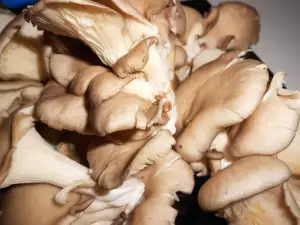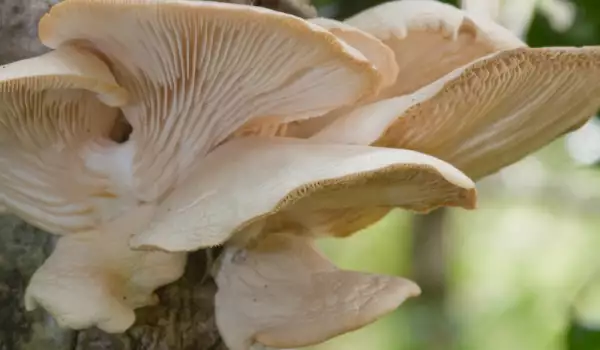The oyster mushroom (Pleurotus ostreatus) belongs to the Pleurotus genus, Basidiomycota phylum. During its stages of development, this type of mushroom grows cylindrical- or other structural shapes, called basidia, where its spores are housed. Because it is so delicious and easy to cultivate, the oyster mushroom is as equally popular as the champignon.
You practically can't mistake the unique form of the oyster mushroom, which unlike champignons, can't be mistaken for the poisonous death cap. The oyster mushroom, which to many is not only nutritious but also medicinal, is tongue-shaped from the stalk to the end of the cap. A remarkable fact: oyster mushrooms, along with other edible mushrooms of the same genus, make up about 25% of the world's cultivated mushroom production.
It enjoys particularly wide popularity and is prolific in nearly all parts of the world because it is extremely easy to grow, plus it is "productive". In the wild, you can usually find it in deciduous forests - its peak is between late fall and the first snowfall.
The oyster mushroom also appears in early spring. It prefers deciduous forest clearings and grows most intensively in rainy weather toward the end of fall before the snow. It's also possible to spot the mushroom in coniferous forests, although the chances of that are quite low.
An additional plus of foraging oyster mushrooms is their very characteristic shape, making them easy to identify among other tree forest mushrooms. Aside from the plain oyster mushroom, there are also the P. cornucopioides and king oyster mushroom P. eryngii. They resemble it but differ in their growing season and habitat. P. cornucopioides appears during the summer and early fall, while the king oyster mushroom can be found growing around the roots of field eryngo.

How to Recognize Oyster Mushrooms
The stem of the oyster mushroom grows out from a tree and is quite hard, especially at the base, with white, dense and tough flesh. The whole mushroom doesn't have any particular taste and smell but when cooked is very delicious. The stipe is bare and has no ring, is white colored. The cap is offset; the stem connecting to the cap is almost always crooked.
The actual cap of the oyster mushroom is remarkably attractive, thin and tongue-shaped at the base, then fanning out and becoming flat toward the edges. The slight indentation of the cap is characteristic of the oyster mushroom, as well as the wavy edges in some cases. The color of oyster mushrooms varies between silver, grey, brownish and other similar shades. A sign of an older oyster mushroom is a more pale color. Young oyster mushrooms are a saturated pasty color, with a smooth and shiny cap. The cap can grow 6″ (15 cm) in width.
The gills of the oyster mushroom are also white, yellowing slightly later on. It's important to note that they are thin and fused well with the stem. The mushroom spores are pale to white colored.
Composition of Oyster Mushrooms
The oyster mushroom is quite rich in nutrients - a whole lot of vitamins, amino acids and minerals, which are important for the body and protect it against the effects of toxic substances. Oyster mushrooms are a low energy density food, making them very suitable for weight loss diets. Oyster mushrooms are thought to contain anticarcinogenic properties. They contain proteins and essential amino acids.
But this does not mean that oyster mushrooms are a source of cholesterol, quite the contrary - unlike meat and eggs they have no cholesterol. The oyster mushroom contains vast quantities of selenium, having almost no competition amongst other foods. Selenium has been proven to lower the risk of prostate cancer. Oyster mushrooms are also an excellent source of potassium, which is important for proper cell function.
Culinary Use of Oyster Mushrooms

Even though it's not distinguished by a specific taste and smell, the oyster mushroom is highly widespread and extremely popular in the culinary world. When prepared right, the oyster mushroom can impress any picky eater. Young caps are preferential for culinary use, the actual cooking is the same as with any other mushroom.
It can be cooked whole or cut into coarse pieces, just be sure to remove the firm stem at the base because it's tough and not always pleasant for consumption. As a matter of fact, the absence of distinct flavor and smell in oyster mushrooms may turn out to be a huge plus because it makes them into a sort "sponge" that thoroughly soak up any other aroma that happens to end up in the pan or pot.
Another bonus to oyster mushrooms is that they don't change color when cooked, unlike champignons for instance. Since the oyster mushroom is a meaty and large mushroom, it is extraordinarily suitable for marinating, grilling and breading. You can preserve an oyster mushroom longer if you marinate it but you shouldn't dry it.
The oyster mushroom also finds other applications outside of the culinary arts. In various parts of the world they are utilizing the mushroom's properties in a positive way - to purify water from oil waste. During the growth stages of the oyster mushroom, its mycelium forms a threadlike web which is deployed at the polluted area, absorbing every last drop of oil.
Benefits of Oyster Mushrooms
As already mentioned, for many folks the oyster mushroom is equally valuable as a food, as well as a medicine. It helps lower cholesterol levels in the blood. The high amounts of potassium in oyster mushrooms aid proper cell function, plus they regulate blood pressure by maintaining optimal balance of water and fats in the body. The rich assortment of vitamins, minerals, amino acids and proteins, without any cholesterol, make the oyster mushroom an excellent protector against toxins.
Growing Oyster Mushrooms

There are several varieties of oyster mushrooms, called strains, which are suitable for growing. Each of them has their own requirements for habitat and climate conditions, as well as different market destinations. The strains are: Les - 1, INRA 3001, Somycel 3001, 3004, 3025, 3200, 3210 and NK 35. Some are summer, others are winter strains. Mycelium from any strain can be bought from specialized labs.
Generally speaking, the oyster mushroom can be grown in 2 ways - either on straw in polyethylene bags, or on wood stumps. When growing it on straw, it needs to be sterilized in order to kill any bacteria, mold and spores of other mushrooms. Only then should the mycelium be injected.
Alternate between layers of straw and crushed injected substrate in a large plastic bag. One package of it is enough for about 44 lb (20 kg) of moist straw, which is how much a standard bin bag holds. Tie the stuffed bags and make up to 10 cuts per bag, about 2" long. If air humidity is low, make smaller cuts, and if necessary you can make new ones later. After you inject the bags, leave them in a relatively shady and ventilated area, away from direct sunlight.
The ideal temperature for growing oyster mushrooms is between 60°F (15 °C) and 80°F (25 °C); the higher it is, the faster the mushroom grows. This also means that the nutrients in the straw are depleted faster, which in turn means that you should adjust the temperature depending on the desired amount of oyster mushrooms.
If the harvest seems too fruitful, put the bags away in a cooler area. The nutrients in the packet will be used up in about 3-4 months, the actual duration of the oyster mushroom harvest. One packet can yield up to 9 lb (4 kg) of oyster mushrooms.



















